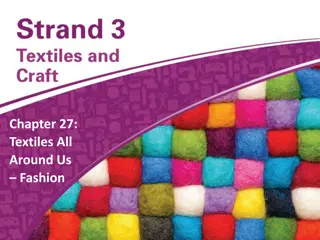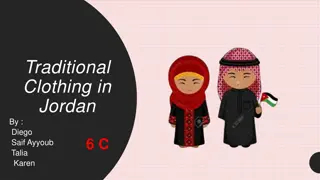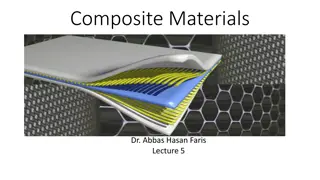Understanding the Properties of Materials for Clothing Selection
Different types of garments are required for varying weather conditions and activities. Fashion designers must comprehend material properties to choose the ideal fabric for maintaining garment functionality. Fabrics like wool and fleece serve as thermal insulators, keeping individuals warm in cold weather. Synthetic fabrics are also effective for winter clothing, with different layers providing optimal insulation, breathability, and protection. Lightweight and breathable fabrics are recommended for warm, humid weather to allow heat dissipation by promoting air circulation and moisture evaporation.
- Fabric properties
- Clothing selection
- Thermal insulation
- Synthetic fabrics
- Weather-appropriate garments
Download Presentation

Please find below an Image/Link to download the presentation.
The content on the website is provided AS IS for your information and personal use only. It may not be sold, licensed, or shared on other websites without obtaining consent from the author. Download presentation by click this link. If you encounter any issues during the download, it is possible that the publisher has removed the file from their server.
E N D
Presentation Transcript
Properties of materials Different garments are needed for different weather conditions and different types of activities. Fashion designers need to understand the properties of materials in order to choose the best fabric for keeping a garment. Some clothing is better suited to cold weather and some is better suited to warm weather. But why is this so?
Thermal fabric Have you ever heard of thermal underwear? It is made from a fabric that prevents heat from escaping. This type of fabric is called a thermal insulator. Its job is to keep us warm in cold weather. Fabrics such as wool and fleece are good thermal insulators.
Wool Wool has long been used to make winter clothing. It is made of thick fibres that trap body heat and prevent it from escaping.
Wool It is a good idea to have a woollen hat, scarf and gloves in your wardrobe for the winter season.
Flannel Flannel is another good option for cold weather. It is a soft, tightly- woven cotton fabric. The surface has a fuzzy feel. It traps air and provides good insulation.
Flannel Fleece is a popular synthetic fabric these days. It has tiny air pockets that provide good insulation. It is also soft and comfortable to wear
Synthetic fabrics Synthetic fabrics are great for winter clothing. For example, a winter jacket often has three layers of different synthetic fabrics with different properties. The lining tends to be soft and breathable. The middle layer is an insulating material to trap heat. The outer layer provides a barrier against the wind and rain.
Synthetic fabrics Conduction is when heat moves from one object to another. Thermal conductors are materials that allow heat to easily pass through them. Some synthetic fabrics are designed to be good thermal conductors, such as those used for sportswear.
Staying cool The best fabrics for warm, humid weather are lightweight and breathable. They conduct heat, or allow heat to escape from your body. They do this by letting air circulate next to your skin and allowing moisture to evaporate.
Cotton Cotton jersey is a thin, stretchy fabric that is well known for breathability. T-shirts are made of this.
Chambray Chambray is a cotton fabric that looks like denim, but is much more lightweight and breathable.
Linen Linen is a lightweight, breathable fabric that absorbs moisture, but dries quickly, keeping you cool. In countries with a warm climate, a lot of clothing is made from linen.
Insulation Did you know that air is a good insulator? The polar bear can keep warm in the Arctic is because its fur contains long, hollow guard hairs that protect its thick undercoat. The air inside the guard hairs provides a layer of insulation, slowing down the transfer of body heat.
Insulation Fabrics with insulating properties work in a similar way. Their fibres are woven together in such a way that the fabric contains millions of tiny air pockets.
Vacuum A vacuum slows down the transfer of heat because there is no air in a vacuum. A flask for hot drinks works on this principal. The flask has two layers of a material such as stainless steel, with a vacuum in between the layers. It keeps the drink hot for hours because it takes a lot longer for the heat to escape.
Illustrations Shutterstock























